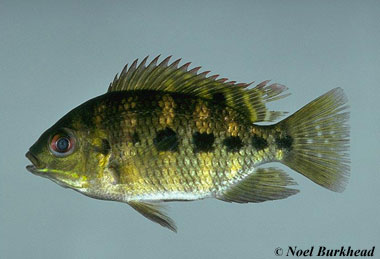
Pelmatolapia mariae
These spotted, barred cichlids have a tolerance to brackish water, and a quick growth and reproduction rate. They are native to Western Africa, but are established in Australia and the US, where they are often considered a nuisance invader. As juveniles, they are barred black over green-gold, but as they age, the bars fade and they just have large dark spots along the mid-lateral. Spotted tilapia pair bond to raise their broods.
Common Names
Common names referring to this species include a-sannoh (Krio), black mangrove cichlid (English), epia ajegi (Yoruba), fünfflecktilapie (German), ifunu (Ijo), marienbuntbarsch (German), mpupa (Igbo), Niger cichlid (English), pondaworkei (Krio), spotted tilapia (English), tha thompo (Krio), tigrovaya tsikhlida (Russian), and ukuobu (Ijo).
Importance to Humans
In West Africa, the spotted tilapia is a source of protein. In areas outside of its native range the species has overrun its new environments to the point of becoming a pest. In Queensland, Australia the species is officially classified as an exotic pest fish and attempts to eradicate it from some areas using methods as drastic as the poisoning of a whole body of water have been implemented. Various other control measures are being researched and possession or transport of the species by unauthorized persons in Australia is a finable offense.
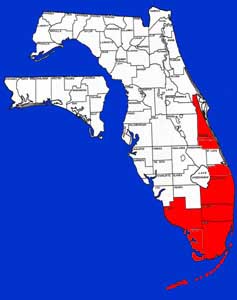
In South Florida, USA, the spotted tilapia (at least in the eyes of some biologists) has earned the ignominious distinction of not only being a rapidly spreading pest species, but having served as a ready-made argument for the state’s existing desire to introduce an additional exotic fish to the area. The piscivorous South American peacock cichlid, Cichla ocellaris, was introduced in the mid-1980’s, ostensibly in part to control populations of the abundant spotted tilapia. To what extent the peacock cichlid has been successful at controlling spotted tilapia or to what degree it has outperformed the native largemouth bass in this capacity is a matter of some debate. Certainly there are now two exotic fishes where once there was one and an ecological equilibrium between predator and prey appears to have been established. Populations of both introduced species are stable and an additional cichlid has joined the roster of introduced fishes in South Florida.
Experimental studies indicate that the present distribution of spotted tilapia is a reflection of the thermal sensitivity of the species. In one study, captive fish subjected to decreasing water temperatures were ultimately unable to survive water temperatures lower than 52.2°F (11.2°C) . However, the same study points out that tilapia are adept at finding the warmest zones of a body of water when challenged with low temperatures and that laboratory findings of a species’ lower lethal temperature depends on a variety of conditions. As such a suite of lower lethal temperatures may actually be more accurate in determining the ultimate distribution of this species in the state. The effect this species may have or be having upon the ecologically similar, native sunfishes (Centrarchidae) is not known.
Conservation
This species is not listed as threatened or vulnerable by the World Conservation Union (IUCN). The IUCN is a global union of states, governmental agencies, and non-governmental organizations in a partnership that assesses the conservation status of species.
> Check the status of the spotted tilapia at the IUCN website.
Geographical Distribution
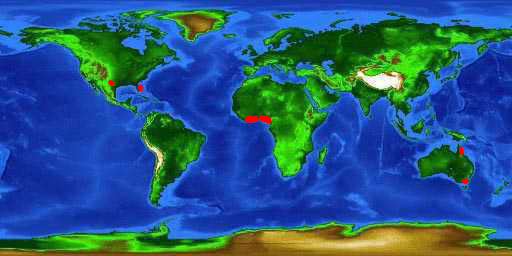
The spotted tilapia is native to West Africa from the coastal lowlands and brackish lagoons of central Ivory Coast to southwest Ghana and from southeast Benin to the Kribi River, Cameroon. Non-native populations are established in Arizona, Florida and Nevada, USA and Queensland and Victoria, Australia. Populations in Florida may be found in no less than eight southern counties, with the first individuals found in Snapper Creek Canal, South Miami in 1974. In many South Florida canals the spotted tilapia is now the most abundant cichlid amongst a host of introduced cichlids.
Habitat

Spotted tilapia inhabit calm, warm waters and in their native range are most common in small streams or the lower reaches of medium-sized rivers. Young and adults alike feel most secure near structure, whether such structure takes the form of the weedy shores of a West African lagoon, the vegetated margins of a forest stream, or the limestone outcroppings of a South Florida canal. Evidence of the ecological plasticity of this species may be found in its extensive record of colonizing non-native areas. Spotted tilapia are tolerant of the brackish water mangroves of Queensland, Australia, have rapidly expanded their range in the aforementioned box-cut canals of South Florida and thrive in the warm springs of Nevada.
Biology
Distinctive Features
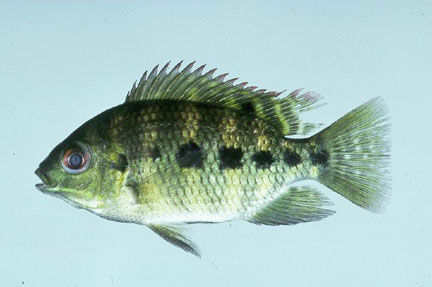
Among cichlids and perciform fishes, spotted tilapia are conventional in size and shape. Their bodies are essentially oval. The spinous and soft dorsal fins are confluent and originate well behind the head. The spinous dorsal is longer than the soft and the rigid spines, more numerous than the soft rays, are sharp. The caudal fin is fan shaped and truncate. The anal fin tapers to a point rearward and is armed with three stout spines in the front. The pelvic and pectoral fins are of a size proportional to the body and their placement is typical for an acanthopterygian fish. The mouth is terminal and the eye is large. The most distinctive features of this species are features of color.
Coloration
Spotted tilapia vary in appearance according to age. Juveniles are not spotted at all, but bear a series of black bars set upon a yellow green or gold background that extend beyond the body and onto the dorsal fins. This disruptive pattern presumably provides the young with some degree of camouflage. As the fish age, the juvenile pattern of bars become faint to absent. The new dress is a series of somewhat irregular, large spots centered near the midline of the body. It is for this series of spots that the species has been given its common name. Even on the largest adults however, it is sometimes possible to discern the faded remnants of their once barred pattern. Beyond this basic pattern, adult fish may also exhibit the occasional splash of pink or even an overall darker body tone depending upon the physical condition of the fish or its environment. Rapid changes in coloration in response to stimuli are not unusual in cichlids and have been noted in Pelmatolapia mariae. The iris of this species is red.
Dentition
The teeth of Pelmatolapia mariae and in fact those of all members of the genus Tilapia tend to be coarser than that of their Tilapiine relatives of the genera Oreochromis and Sarotherodon. This includes both the teeth of the jaws and teeth of the throat or “pharyngeal” teeth. The teeth of juvenile spotted tilapia are much finer than those of the adults. Overall the teeth are small and one must look closely to see them.
Size, Age & Growth
Information regarding the age and growth of this species is scant and/or difficult to access. Maximum recorded size for this species, based upon a male from the introduced population in South Florida, USA is 15.5 inches TL (394 mm) and 3 pounds (1,360 grams). An extraordinarily large specimen, average maximum size is likely much smaller. Female spotted tilapia are known to reach sexual maturity at sizes as small as 3.5 inches SL (90 mm).
As sexual dimorphism is thought to be uncommon or minimal in Tilapia, Pelmatolapia mariae appears to be unusual in that at least one source cites male T. mariae as obtaining a larger size than females. Males may also possess larger and more colorful dorsal fins in addition to a steeper head profile.
Food Habits
Pelmatolapia mariae feed on “aufwuchs,” which refers to the many types of periphyton found growing on various substrates such as plants or rocks as well as the microorganisms found amongst the periphyton. In rich or eutrophic environments, spotted tilapia have been known to feed on phytoplankton. Hook and line fishers have found bread balls to be adequate bait for this species.
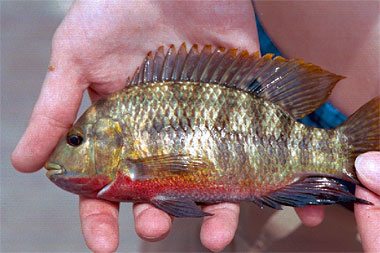
Reproduction
Spotted tilapia form pair bonds well in advance of the act of spawning and remain together to care for their young. While a pair tends a brood together, whether their offspring are in the egg stage or have hatched, they are reported to be monogamous. Spawning in this species is believed to take place in the spring and fall. Peak spawning may be related to the lunar cycle — at least for those spotted tilapia inhabiting clear waters. Spawning in relation to lunar periodicity is an unusual trait for a freshwater fish, but it is thought that such a strategy may provide adult spotted tilapia a better opportunity to defend their young from nocturnal predators as they tend to spawn in synchronization with the full moon. Spotted tilapia typically gather together in breeding colonies.
Spotted tilapia are substrate spawners that prefer the clean underside of rocky surfaces for egg deposition. Females produce approximately 200-400 bluish colored eggs, approximately 1.8mm in diameter, that adhere to the substrate upon which they are laid. Two days or so after spawning the female will remove all fertile eggs to a nearby pit, returning to the original spawning site to consume any infertile eggs. Early stage larvae of Pelmatolapia mariae possess “head glands,” an unusual feature that allows young tilapia to secure themselves to the substrate via a thread like structure produced by these glands. Secure from the perils of drifting away prior to having developed a functional swimming ability, the nascent tilapia are thought to enjoy the added benefit of having risen above the siltier, less oxygenated waters of the bottom. Young enjoy the protection of both parents and are free swimming at approximately 9 days.
A population of Pelmatolapia mariae in Perrine, South Florida produced hybrid offspring with a related, introduced species, Tilapia zilli, the redbelly tilapia.
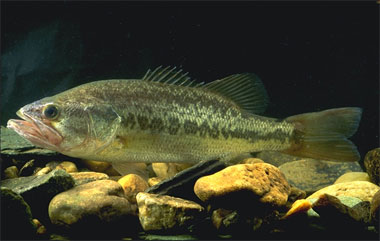
Predators
Spotted tilapia are prey to a variety of organisms including other fishes, birds, reptiles, and humans.
Parasites
Cichlidogyrus testificatus, a monogenetic trematode (flatworms) is reported to parasitize Pelmatolapia mariae.
Taxonomy
The famous British herpetologist George Albert Boulenger, who made a number of contributions to ichthyology, described the spotted tilapia as Tilapia mariae in 1899. The name remains in use today. Later workers, believing in error that their Tilapia specimens were an undescribed species created the synonyms Tilapia dubia Lönnberg 1904 and Tilapia meeki Pellegrin 1911.
Prepared by: Robert H. Robins